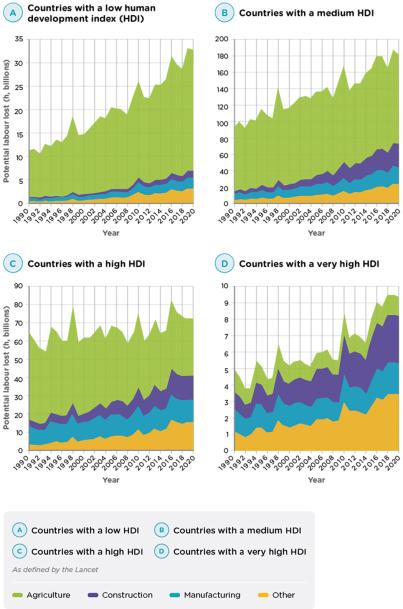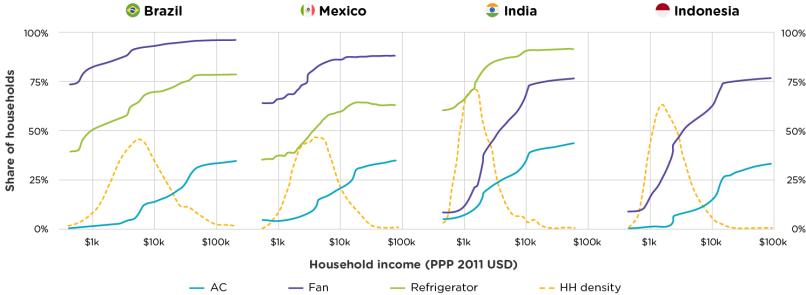Cooling for human comfort and safety
Key messages
- Life doesn't stop when temperatures hit 35°C, but people's ability to adapt and thrive in heat suffers.
- Science shows that threats to our productivity and even health grow exponentially with rising temperatures.
- Cooling already consumes 17 percent of global electricity demand, which could triple by 2050, challenging the ambition of net-zero economies and keeping SDG7 out of reach.
356,000
deaths caused by extreme heat in 2019 (The Lancet).
295 bn
hours of potential work were lost to heat stress in 2020.
2.5 bn
total number of space-cooling units owned globally in 2030 (CLASP).
Overview
Access to sustainable cooling can support achieving SDGs on health and well-being (SDG3), education (SDG4), poverty (SDG1), employment (SDG8) and sustainable cities and communities (SDG11) by delivering human comfort and safety. Cooling of cities, homes and places of employment supports improved sleep, alertness and ability to learn for students, as well as worker productivity that provides higher incomes for families and improved resilience for communities. In many settings, improving human comfort and safety with cooling requires access to affordable and clean electricity (SDG7).
Increasing risks to human health due to extreme heat
A warming world is increasing the risks to mental and physical health. [1] Insufficient action on climate change adaptation and the growing impacts of extreme heat on human lives underline the urgency to accelerate progress on investing in and delivering sustainable cooling for all.
In 2014, WHO released a study estimating that 12,000 people lose their lives annually due to extreme heat waves, a figure that could rise to 255,000 annually by 2050 without adaptation. [2] New research for The Lancet has shown that the scale of the challenge is already much larger, with extreme heat causing the deaths of 356,000 people in 2019 alone. [3]
The scale of this impact, at an estimated 1.1°C of global warming, is likely to grow globally as temperatures continue to rise, posing significant risks for vulnerable groups. At between 2°C and 3°C of warming, 16 times as many people would be exposed to heat waves, rising to 36 times as many people at 4°C, causing severe risk of heat-related mortality. [4]
Vulnerable groups include newborns, children and those over the age of 65. Estimates indicate that children younger than one year and adults over 65 were exposed to 3.1 billion more per-person days of heat waves in 2020 compared to the average between 1986 and 2005. [5] In fast-growing Africa, limiting global warming to 1.8°C by 2100 will still mean that as the climate changes and the growing population ages, the number of Africans below age five and over 64 exposed to heat waves will increase from 27 million in 2010 to 360 million in 2100. [6]
Human comfort and safety for worker productivity and improved incomes
Workers face high risks from heat. The International Labour Organization (ILO) estimates that the world will suffer a worker productivity loss equivalent to 80 million full-time jobs in 2030 due to heat stress. [7] In 2018, an analysis in 30 countries found that approximately one in three individuals who are exposed to heat stress in their job experienced negative health effects. [8] In this context, labour productivity is also threatened, with the number of work hours lost due to heat increasing significantly in the last 20 years. [9] Some regions are already experiencing heat stress that affects labour productivity, and in 2020, 295 billion hours of potential work was lost. Unsurprisingly, the three Critical 9 countries in South Asia (Bangladesh, India and Pakistan) experienced losses two-and-a-half to three-times higher than the world average. [10]
Figure 2.19: Potential labour lost due to heat-related factors in selected sectors (1990–2020)

In rural areas, extreme temperatures threaten many livestock and crops. Agricultural productivity growth in Africa has already seen a decline of 34 percent since 1961 due to climate change, more than any other region. [11] For poor rural populations, threats to agricultural livelihood assets risk triggering persistent poverty traps. For example, extreme heat waves in densely populated agricultural areas of South Asia risk increasing heat stress for farmers, while also constraining their ability to take adaptive actions. [12]
Human comfort and safety for improved learning
Children are particularly vulnerable to a lack of access to sustainable cooling, especially those living in extreme poverty and high-temperature environments. This includes the classroom, where WHO recommends a temperature of 19°C to maintain a comfortable and productive learning environment. Children respond slower during heat waves than adults, making them more likely to suffer from heat strokes and heat-related illnesses and exposure to heat extremes and high humidity rates. Low rates of access to safe drinking water are linked to fewer years of schooling. [13] Studies have shown that students score lower in high temperatures, that low-income students are disproportionately
impacted, and access to cooling can mitigate most of these effects. [14] Fans and air conditioners can support better outcomes, but even passive solutions can help. In a rural area near Hyderabad, India, a passive cool roof on a school was found to reduce average classroom temperatures by 2.1°C and peak temperatures by 5°C relative to uncoated classrooms. [15]
Human comfort and safety for resilient communities and adaptation
In rapidly growing urban areas, the vulnerability of poor households is amplified by informality, exposure to air pollution and the urban heat island effect, lower quality housing, and limited access to green spaces and public services. Megacities like Buenos Aires, Rio de Janeiro and Sao Paulo alone will soon account for 22 million people exposed to growing heat stress. In South and Southeast Asia, up to 1.1 billion urban dwellers could experience heat waves lasting more than 30 days a year by 2080. In Africa, even with 1.7°C of global warming, the exposure of the urban population to extreme heat could increase more than 20 times, up to 45 billion per-person days by the 2060s, with greatest impacts in West Africa. [16]
Cooling solutions for human comfort and safety
Human tolerance to heat has physiological limits. Higher average and extreme temperatures will cause these limits to be reached more regularly in the coming decades, especially in tropical regions. [17] Access to adequate cooling solutions will be fundamental, and demand for air-conditioning is expected to soar, driven by growing income levels and the need to adapt to global warming. [18] However, faster diffusion of inefficient units could lead to unintended consequences that include higher emissions, higher peak electricity demand, brown or blackouts, a more pronounced urban heat island effect, and heat inequities for those not able to afford air-conditioning.
As household incomes increase in developing countries, trends show that air conditioner, fan and refrigerator ownership also increases (Figure 2.20). In India, refrigerator ownership among low-income households is much higher than that of either fans or air conditioners, while fan ownership is much higher in both Brazil and Mexico.
Figure 2.20: Cooling technology use by household income (PPP 2011 USD)

The availability and affordability of sustainable cooling solutions underpin how most vulnerable populations can achieve comfort and safety. Strategies to reduce heat-related risks and improve thermal comfort can include a range of cooling solutions (see Chilling Prospects 2020, Chapter 4) including passive cooling, nature-based solutions, energy-efficient and climate-friendly air-conditioning, and heat-stress planning policies.
Passive cooling is an effective first-order cooling solution that can provide thermal comfort independently depending on heat tolerance and contribute to reduced energy demand for cooling in high-temperature environments where mechanical cooling is necessary, as well as provide respite from extremely high temperatures. In urban poor settings where informal households do not have access to quality electricity and cannot afford active cooling solutions, the use of cool roofs has proven to be a cost-effective solution that can improve resilience among this vulnerable population.
Nature-based cooling includes trees, vegetation, urban greening, water storage and moving water that can reduce temperatures, help offset the urban heat island effect, and improve air quality. Nature-based solutions can be installed either at the property or through urban planning designed and invested in at the community scale. Despite the benefits, cities currently invest less than 0.3 percent of their infrastructure budgets on nature-based solutions. [20]
|
The first chief heat health officers Personnel can be a part of policy, as demonstrated by the creation of the First Chief Heat Health Officers in 2021. In partnership with the Adrienne Arsht-Rockefeller Foundation Resilience Center, the cities of Athens, Greece; Freetown, Sierra Leone; Santiago, Chile; and Miami Dade County in the US have appointed the world’s first Chief Heat Officers to raise awareness of heat risks and lead planning efforts to respond to heat waves. The positions are designed to ensure each city has a person responsible for heat health and the protection of vulnerable residents by providing access to cooling. Learn more. |
Active (mechanical) solutions are generally effective in managing thermal discomfort in high temperature and humid locations. [21] Here, access to reliable electricity is an important factor to make active cooling solutions available. Affordability also drives the type of solution that would be utilized since capital and operating costs can be significant, particularly in poor settings. Owning a ceiling or a table fan is typically the first active space-cooling solution accessed by poor populations that have only tier 1 electricity access. But with higher quality electricity access and greater affordability among lower-middle income and middle-income populations, ownership rates increase for more advanced solutions such as evaporative coolers and air conditioners. Air conditioning is proven to strongly protect against the adverse health effects of extreme heat, to reduce thermal discomfort, and to improve indoor workplace productivity. [22]
According to CLASP, it is estimated that total global ownership of space-cooling solutions such as ceiling fans will reach about 2.5 billion units in 2030, with the number of air conditioners increasing to around 1.5 billion units. [23] The energy demand from these appliances is expected to reach about 2,500 TWh, with 98 percent of this demand from air conditioners. [24] Improving the efficiency of portable fans should be considered as important as fixed appliances, as they can be the first tier 1 active cooling solutions that vulnerable groups access and rely on in conditions of unreliable electricity supply and energy poverty. Policy support for cost-effective energy-efficient ceiling fans would not only improve energy poverty conditions but also extend energy access by reducing waste energy.
|
The role of minimum energy performance standards Minimum energy performance standards (MEPS) and high energy performance standards (HEPS) are policy measures that can support improving the energy efficiency of air conditioners to minimize energy demand, improve affordability, and lower emissions. The UN Environment Programme (UNEP) United for Efficiency (U4E) initiative, for example, estimates that electricity for air-conditioning accounts for up to 60 percent of summer loads in metropolitan areas in hot climates, and that the most efficient air conditioners are 30 percent more efficient than the average products on the market. [25] To this end, it has published a model regulation for air conditioners and has supported a number of countries, including Nigeria and Sudan, in implementing higher performance standards for air conditioners. |
Air conditioners use refrigerants such as HCFCs (hydrochlorofluorocarbons) and HFCs (hydrofluorocarbons) that are short-lived climate pollutants and substances with high Global Warming Potential (GWP) currently controlled through the Montreal Protocol. It has been estimated that by promoting energy-efficient air conditioners and refrigerators along with climate-friendly refrigerants, around 0.4°C of global average temperatures could be avoided by the turn of the century. [26]
In the Critical 9 countries, ownership of active cooling solutions is increasing as both population and income levels grow (Figures 2.21, 2.11, 2.23) and as electrification rates improve, ownership of such appliances is expected to increase further. The International Energy Agency (IEA) estimates that energy demand for space cooling will reach 30 percent of the total final energy consumption by 2050. [27]
Figure 2.21: Air conditioner stock trends in the Critical 9
Figure 2.22: Ceiling and portable fan stock trends in the Critical 9
Figure 2.23: Refrigerator and freezer stock trends in the Critical 9
Notes and references
[1] It's official: July was Earth's hottest month on record. National Oceanic and Atmospheric Administration, 13 August 2021. Link.
[2] WHO (2014). Quantitative Risk Assessment of the Effects of Climate Change on Selected Causes of Death, 2030s and 2050s. Link.
[3] Burkart, et al, Health in a World of Extreme Heat, The Lancet Vol 398, August 2021. Link.
[4] Intergovernmental Panel on Climate Change, Sixth Assessment Report: Impacts, Adaptation and Vulnerability. 28 February 2022. Link.
[5] Romanello, Marina et al, The 2021 report of The Lancet Countdown on health and climate change: code red for a healthy future. The Lancet, Vol. 398, Issue 10311. 30 October 2021. Link.
[6] Intergovernmental Panel on Climate Change, Sixth Assessment Report: Impacts, Adaptation and Vulnerability. 28 February 2022. Link.
[7] Kjellstrom T, et al. Working on a warmer planet: the effect of heat stress on productivity and decent work. 2019. Link.
[8] Flouris AD, Dinas PC, Ioannou LG, et al. Workers’ health and productivity under occupational heat strain: a systematic review and meta-analysis. The Lancet Planetary Health 2018; 2: e521–31. Link.
[9] Intergovernmental Panel on Climate Change, Sixth Assessment Report: Impacts, Adaptation and Vulnerability. 28 February 2022. Link.
[10] Romanello, Marina et al, The 2021 report of The Lancet Countdown on health and climate change: code red for a healthy future. The Lancet, Vol. 398, Issue 10311. 30 October 2021. Link.
[11] Intergovernmental Panel on Climate Change, Sixth Assessment Report: Impacts, Adaptation and Vulnerability. 28 February 2022. Link.
[12] Ibid.
[13] https://www.unicef.org/media/105376/file/UNICEF-climate-crisis-child-rights-crisis.pdf
[14] https://www.hks.harvard.edu/announcements/when-heat-student-learning-suffers and https://www.researchgate.net/publication/283837937_Effects_of_HVAC_on_student_performance
[15] https://www.researchgate.net/publication/282620876_Assessment_of_the_Impact_of_Cool_Roofs_in_Rural_Buildings_in_India
[16] Intergovernmental Panel on Climate Change, Sixth Assessment Report: Impacts, Adaptation and Vulnerability. 28 February 2022. Link.
[17] Ebi K. L. et al., 2021, P698-708, 21 August 2021. Link.
[18] IEA, 2018, The Future of Cooling, IEA, Paris. Link.
[19] Pavanello, F., De Cian, E., Davide, M. et al. Air-conditioning and the adaptation cooling deficit in emerging economies. Nat Commun 12, 6460 (2021). Link.
[20] BiodiverCities by 2030: Transforming Cities’ RelationShip with Nature, World Economic Forum, January 2022. Link.
[21] Ollie J. et al., Reducing the health effects of hot weather and heat extremes: from personal cooling strategies to green cities. P709-724, August 21, 2021. Link.
[22] Ollie J. et al., Reducing the health effects of hot weather and heat extremes: from personal cooling strategies to green cities. P709-724, August 21, 2021. Link.
[23] CLASP: Mepsy: The Appliance & Equipment Climate Impact Calculator. Link.
[24] CLASP: Mepsy: The Appliance & Equipment Climate Impact Calculator. Link.
[25] United for Efficiency, Approach to Air Conditioners. Link.
[26] Dreyfus et al. IGSD 2019.
[27] IEA, Future of Cooling, 2018.


